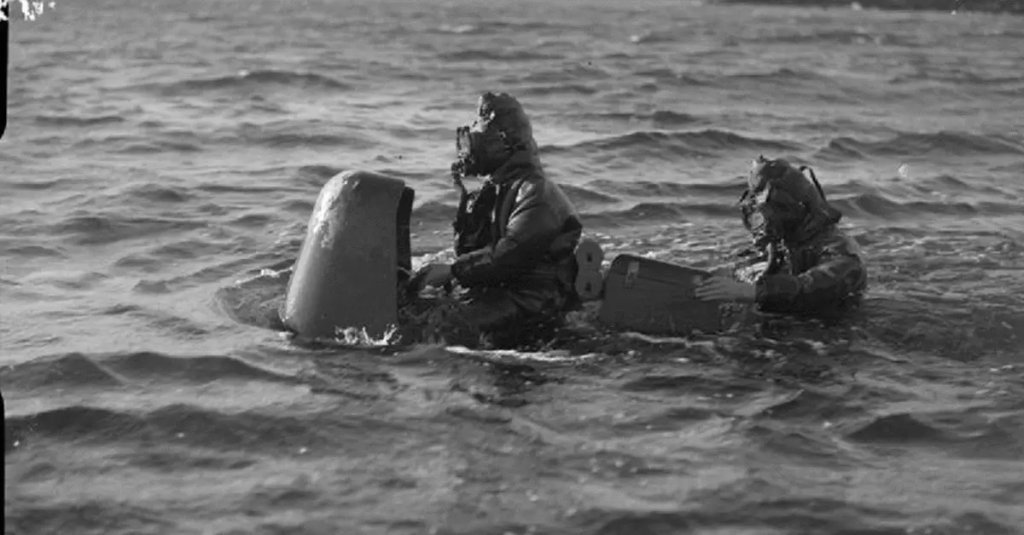

You’ve probably heard about Japan’s Kamikaze tactics, and maybe you’ve even heard about Japan’s manned rockets and torpedoes. But, oddly enough, Japan wasn’t the only combatant in World War II that had manned torpedoes. Britain used manned torpedoes and did so years before Japan.

But there is an important distinction between the two programs. Britain’s manned torpedoes were designed with a focus on getting the pilots back safely after the mission, while Japan’s program was essentially Kamikaze tactics, but under the water.
For Britain, it all started in December 1941. Less than two weeks after Pearl Harbor, Britain suffered its own surprise naval raid on December 19. Two British battleships and a tanker suffered serious damage in the Port of Alexandria in Egypt when large explosions ripped through their hulls from outside.
But the captain of the HMS Valiant had captured two Italian divers just before the explosions, and one of them had asked to meet with him just before the blasts. Coincidentally, they had been detained in the room just above the damage to the hull. So he summoned those dudes again and asked what, exactly, had happened to his ship and the two others. (A fourth ship was damaged by the blasts, even though the Italian teams had only hit three targets.)

Four other divers were captured by Egyptian police in the following days, and Britain pieced together how the attacks were carried out. The men had launched from an Italian submarine on a torpedo modified to propel the divers through the water. These torpedoes not only had warheads, but they also had two little seats for the divers.
Basically, imagine a two-person motorcycle, but shaped to fit in a large torpedo tube and propelled by a propeller instead of wheels. Now attach a mine to the front. Or you could’ve just looked at the picture above, but whatever. Let’s keep going.
Britain saw this and was all, “Hey, Brits can be strapped to metal tubes, too! We should strap dudes to metal tubes.” So they developed the Chariot starting in April 1942 and attempted the first manned torpedo mission that October.

The British Chariot Mk. I was about 22 feet long, 3 feet wide, and weighed over 1.75 tons and had a 600-pound Torpex warhead, equal to almost a 1,000 pounds of TNT. The plan was that divers would get onto the torpedo and steer it through the water to a target. Then the divers would remove the warhead from the torpedo and place it on the target ship’s hull with a timer, and then pilot the submersible away.
If all went to plan, the 600 pounds of high explosive would then blow a large hole in the target.
The first Chariot mission failed after the torpedoes were lost at sea as a ship delivered them into range of their target. Their target, by the way, was the German battleship Tirpitz, which would’ve made for an epic combat debut if it had succeeded.
But Britain modified submarines to carry the new torpedo and began sending the Chariot into combat.

Chariot torpedoes were used against Italian ships, the beaches of Sicily, and Japanese ships in Phuket, Thailand. And, yeah, it turns out those massive warheads do work. Britain even made a new design of Chariot, the Mk. II Terry Chariot, that was faster, had a warhead twice the size, and a larger combat radius.
But if it was so good, why aren’t there a bunch of manned torpedoes zipping around today? Well, there are actually a few. The U.S. Navy has the SEAL Delivery vehicle which is, basically, a manned torpedo that SEALs use to get to targets, but the Navy is looking to can it and get mini-subs instead. These would perform the same mission, but SEALs wouldn’t need to be exposed to the outside water in the mini-subs.
But yeah, manned torpedoes have mostly given way to submersibles and mini-subs because manned torpedoes were really valuable for delivering divers. When it comes to delivering warheads, even during World War II, it made more sense to fire conventional torpedoes.
Today, guided torpedoes make the use of manned torpedoes for explosive delivery completely unnecessary.
